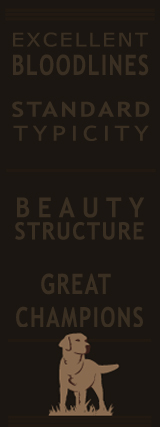Regions of the body of the Labrador
The dog's body is described by regions. Each corresponds to a precise anatomical area. Fifty-two regions are described. These enable an expert or a judge, in an exposition, to evaluate the sample presented and explain the decisions to the owner.
Head, neck and forelimbs:
The head may be round (Cavalier King Charles) or square. It plays an important role in the balance. The long-headed races usually have a pointed snout and the square head's has short and muscular jaws (this applies mainly to breeds which originally were intended for combat).
On the head there are two major regions: in the back, the skull, which houses the brain, and in the front, face, containing the nasal cavities. The middle region is centered on the two orbits. The different relationships between the skull and the face let us define the dolichocephalic (long snout), the brachycephalic (short snout and flat) and mesocephalic (between the two).
The head includes other regions not so well defined. The temples are located laterally behind the eyes and are limited to below by the zygomatic arches, touching the braincase and quite important influence in determining the morphology of the head. The parotid region is below the ears and behind the masseteric region. The latter in turn is located behind the cheek, very small due to the large mouth opening in the dog. The neck is moderately prominent to the back at the neck and throat may have skin folds, which are called the dewlap.
The neck is shaped like a cylinder with a diameter end chest bigger than the head. Dorsally ends on the cross at an angle more or less open to the back.
It is an important region in the appreciation of the beauty of the dog. It influences the demeanor of the head and the balance of the animal, as it regulates the position of center of gravity. The shaft head - neck plays the role of a seesaw cervicephalic balancing the rest of the spine and this is what the dog uses during the movement (for example, when a dog has the head and neck supported on the ground, it cannot get up).We Continue with the shoulders, the cross and the sill. His position changes depending on the walk, standing in the boost phase and lying on the reception phase.
The forelegs are usually long and slightly flattened. The shoulder has an angle, from above and behind downwards and forwards, and it is slightly convex. The arm borders with the shoulder upwards and downwards with the elbow, which is more or less stuck to the chest wall. The two middle fingers are longer and thicker than the sides. The digital pads (thickened stratum corneum with more fat) are outgoing and somewhat convex. The nails are curved and curvy, and the tips of the fingers should not touch the ground when standing.


 — Phone: (54 011) 4650-1921 / (54 011) 15-6507-3039
— Phone: (54 011) 4650-1921 / (54 011) 15-6507-3039